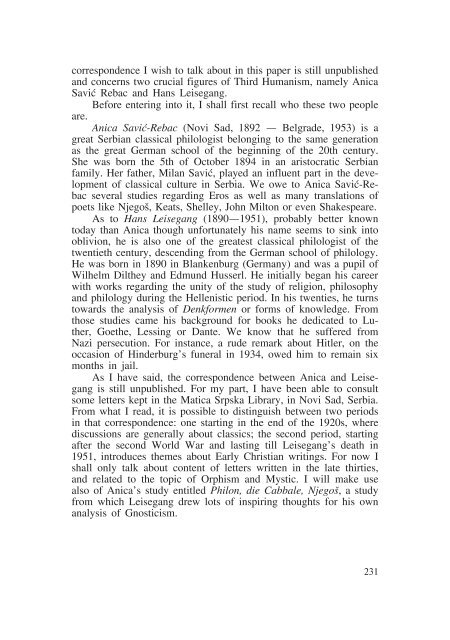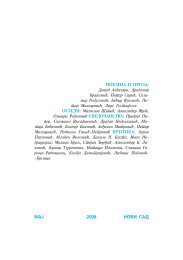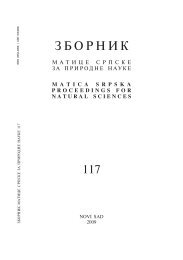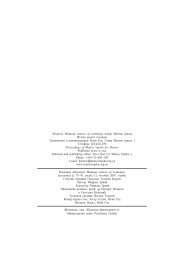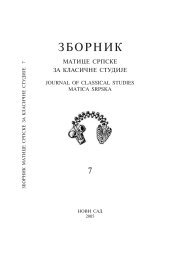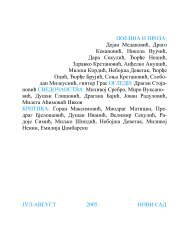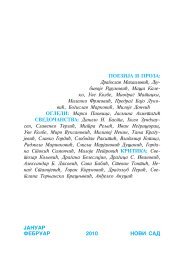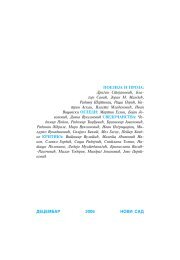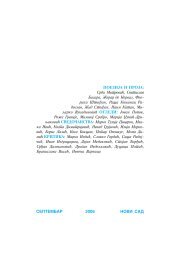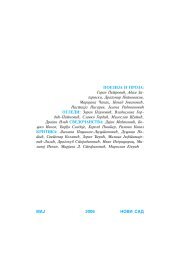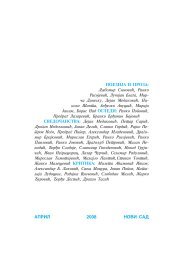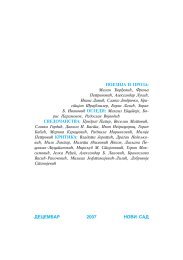Create successful ePaper yourself
Turn your PDF publications into a flip-book with our unique Google optimized e-Paper software.
correspondence I wish to talk about in this paper is still unpublished<br />
and concerns two crucial figures of Third Humanism, namely Anica<br />
Saviã Rebac and Hans Leisegang.<br />
Before entering into it, I shall first recall who these two people<br />
are.<br />
Anica Saviã-Rebac (Novi Sad, 1892 — Belgrade, 1953) is a<br />
great Serbian classical philologist belonging to the same generation<br />
as the great German school of the beginning of the 20th century.<br />
She was born the 5th of October 1894 in an aristocratic Serbian<br />
family. Her father, Milan Saviã, played an influent part in the development<br />
of classical culture in Serbia. We owe to Anica Saviã-Rebac<br />
several studies regarding Eros as well as many translations of<br />
poets like Njegoš, Keats, Shelley, John Milton or even Shakespeare.<br />
As to Hans Leisegang (1890—1951), probably better known<br />
today than Anica though unfortunately his name seems to sink into<br />
oblivion, he is also one of the greatest classical philologist of the<br />
twentieth century, descending from the German school of philology.<br />
He was born in 1890 in Blankenburg (Germany) and was a pupil of<br />
Wilhelm Dilthey and Edmund Husserl. He initially began his career<br />
with works regarding the unity of the study of religion, philosophy<br />
and philology during the Hellenistic period. In his twenties, he turns<br />
towards the analysis of Denkformen or forms of knowledge. From<br />
those studies came his background for books he dedicated to Luther,<br />
Goethe, Lessing or Dante. We know that he suffered from<br />
Nazi persecution. For instance, a rude remark about Hitler, on the<br />
occasion of Hinderburg's funeral in 1934, owed him to remain six<br />
months in jail.<br />
As I have said, the correspondence between Anica and Leisegang<br />
is still unpublished. For my part, I have been able to consult<br />
some letters kept in the <strong>Matica</strong> Srpska Library, in Novi Sad, Serbia.<br />
From what I read, it is possible to distinguish between two periods<br />
in that correspondence: one starting in the end of the 1920s, where<br />
discussions are generally about classics; the second period, starting<br />
after the second World War and lasting till Leisegang's death in<br />
1951, introduces themes about Early Christian writings. For now I<br />
shall only talk about content of letters written in the late thirties,<br />
and related to the topic of Orphism and Mystic. I will make use<br />
also of Anica's study entitled Philon, die Cabbale, Njegoš, a study<br />
from which Leisegang drew lots of inspiring thoughts for his own<br />
analysis of Gnosticism.<br />
231


